During the first ten minutes of class, write a summary memo on chapter 5, “Online Language and Social Interaction” from Jones and Haffner’s Understanding Digital Literacies. After you’ve had a chance to write your memo and post it as a comment to this blog entry, we will discuss the chapter in depth before turning our attention toward Project 3.
Author Archives: Jason W. Ellis
Project 3, Planning
Before class on Thursday, copy-and-paste your planning memo for Project 3, Photography and Photosharing in a comment made to this blog post. Remember, we will use this memo as the basis for our in-class work during Thursday’s class, so it’s vitally important to complete it in time for our next meeting. Also, we will discuss chapter 5, “Online Language and Social Interaction” from Jones and Hafner at the beginning of Thursday’s class.
Take a Moment to Enjoy the Sunshine
Beginning of Class Writing: Understanding Digital Literacies, Chapter 4, Multimodality
During the first ten minutes of class, write a summary memo of chapter four titled “Multimodality” from Jones and Hafner’s Understanding Digital Literacies. Post it here as a comment to this blog entry.
Project 2, Structure
During today’s class, you will have some time to continue transforming your think piece essay into a speakable script for your podcast. Instructions are included below from the assignment sheet.
Structure: Create a new document and copy-and-paste your think piece into it. During class, we will work together to turn your essay into a podcast script. Key components to add: an introduction for yourself, your podcast series, and your podcast episode; pauses and bridges; and an outro to close your podcast episode. All references need to be incorporated into what you say. Background or bridge music is encouraged, but not required due to the limitations of time. If you choose to use music, it must be music that you own or have the rights to (such as OpenMusic, https://musopen.org, Free Music Archive, http://freemusicarchive.org, or Creative Commons Search, https://search.creativecommons.org but note license terms, https://creativecommons.org/licenses/ and issues of fair use, http://fairuse.stanford.edu). (in-class on Feb. 25)
Using your script, you will record your podcast speech and save any sound effects or background music that you might want to use. Bring these things to class on Tuesday. Have all of this easily accessible from your flash drive/email/cloud-based storage so that we can work on these during class. If you want to work ahead, please do so. During class, you can fine tune your own work or help others in class.
Beginning of Class Writing: Jones and Haffner, Understanding Digital Literacies, Chapter 3
During the first ten minutes of class on Thursday, write a summary of your reading of the “Hyperreading and Hyperwriting” chapter from Jones and Hafner. Incorporate your own experiences and observations in your summary. Copy-and-paste your summary memo into a comment made to this blog post.
Project 2, Planning
Copy-and-paste your planning memo into a comment made to this blog post. We will continue with the podcast project during class today when we listen to samples of your think piece recordings.
Beginning of Class Writing: Jones and Haffner, Understanding Digital Literacies, Chapter 2
During the first ten minutes of class, create a new document in your word processor of choice, and format it as a memo with the subject taken from the title of this blog post. In the memo’s body, write a summary of your reading from chapter two from Understanding Digital Literacies. Save your work and copy-and-paste it into a comment to this blog post. Afterwards, we will discuss the reading in greater depth.
Project 1, Archive
After you have had a chance to read over and revise your think piece draft (submitted as a comment to the Project 1, Execute blog post), you are ready to complete the assignment and create a blog post, which can be incorporated later into your portfolio. Follow the directions below from the assignment sheet to create your blog post on our OpenLab site before class on Thursday, Feb 18.
Archiving: Create a blog post on our OpenLab site with a catchy and engaging title with your byline. For example: Something Funny Happened on the Way to the Forum by Julius Caesar. In the body of your blog post, copy and paste your completed think piece essay from the previous module. Confirm that it is formatted correctly and it has a Works Cited list at the bottom with MLA formatted bibliographic entries for your quoted sources. Following your essay and works cited list, enter a horizontal line (from the tool palette). Then, write a 250-word reflection on how you wrote your think piece, the audiences that you are attempting to reach, and how the medium of online writing (blogging) shaped the way you wrote your think piece. Publish your blog post to complete the assignment. (due on Feb. 18)
Project 1, Execution
During today’s class, you will execute the writing of your think piece. Of course, you have done much of the heavy lifting needed to write your think piece quickly through the previous modules. Follow the directions below, save your work on your own media, and copy-and-paste your writing into a comment of this blog post. The version of your think piece that you write today can be considered a draft, which you revise before archiving in the final step.
Execution: Copy and paste your outline into a new document. Working through your outline, elaborate on each point so that each paragraph develops your think piece’s narrative of exploring, working out, or understanding the issue better. As you do this, you can delete your outline’s headings so that the further you progress, your think piece will look more like an essay emerging from your notes. When you encounter a quote, explain it and engage it into your discussion. Make sure that you cite it and move the bibliographic info to a new “Works Cited” list that you create at the end of this document. As you progress, always think about how to transition from one paragraph to the next so that your narrative flows from point to point, paragraph to paragraph. Share this document with someone in class to read and provide you with written feedback. Aim as close as possible to 750 words inclusive of your works cited. (in-class on Feb. 16)




